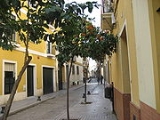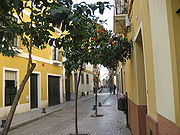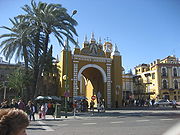
Macarena, Seville
Encyclopedia
La Macarena is the traditional and historical name of the area of Seville
(Spain
) located north of the city center. Nowadays, La Macarena is the name of the neighborhood placed on both sides of the north city wall, but also a much bigger administrative district of Seville
.
, others maintain that it is from Latin
.
Regarding Latin, Macarena would be derived from the male name Macarius. It is supposed that a patrician named Macarius would have been an important Roman
landowner in this area.
On the other hand, it is known that during Muslim
rule, the still existing city-wall gate was named Bab-al-Makrin, which could be related with to the current denomination Macarena.
The neighbourhood of La Macarena lends its name to the sculpture of Our Lady of Hope Macarena, sometimes known simply as Macarena Many Sevillian women are named after this statue. It should be noted that this is, in origin, the reason of the name of the Los del Río
's Spanish hit song Macarena
.
. The procession in the early morning of Good Friday
is one of the largest, most popular, and fervent in the whole of Spain. The wooden statue of Our Lady of Hope Macarena dates from the 17th century. The Neobaroque Basilica was built by Aurelio Gómez Millán in the 20th century. Next to the church is placed the Museum and Treasure of La Macarena, where the huge artistic and sentimental patrimony of the brotherhood is exposed, working as a complete explanation about the famous Holy Week processions of Seville.
The largest remaining portion of the Almohad city walls persists in La Macarena neighbourhood. It spans between two of the old city gates, from the monumental Puerta de la Macarena (Macarena gate) at west, next to the Basilica, to the Puerta de Cordoba (Córdoba gate) at east, annex to San Hermenegildo church. The Parliament of Andalusia
The Parliament of Andalusia
is housed in the old building of the Hospital de las Cinco Llagas
(literally, Hospital of the Five Holy Wounds). Dated from 16th century, it is one of the best examples of Andalusian Mannerism
.
The Torre de los Perdigones (literally, Tower of the Pellets), placed in Los Perdigones gardens next to the Guadalquivir
river, is the last remain of a foundry building from the late 19th century. Since 2007 it contains a panoramic room-sized camera obscura
..
In the nearby Feria street is located the oldest marketplace of Seville, the Mercado de la Feria. The building dates from 18th century and the greengrocer's, butcher's and fishmonger's stalls constitute a traditional and picturesque scene of Seville daily life.
and Los Remedios
.
Seville
Seville is the artistic, historic, cultural, and financial capital of southern Spain. It is the capital of the autonomous community of Andalusia and of the province of Seville. It is situated on the plain of the River Guadalquivir, with an average elevation of above sea level...
(Spain
Spain
Spain , officially the Kingdom of Spain languages]] under the European Charter for Regional or Minority Languages. In each of these, Spain's official name is as follows:;;;;;;), is a country and member state of the European Union located in southwestern Europe on the Iberian Peninsula...
) located north of the city center. Nowadays, La Macarena is the name of the neighborhood placed on both sides of the north city wall, but also a much bigger administrative district of Seville
Seville
Seville is the artistic, historic, cultural, and financial capital of southern Spain. It is the capital of the autonomous community of Andalusia and of the province of Seville. It is situated on the plain of the River Guadalquivir, with an average elevation of above sea level...
.

Etymology of the toponym Macarena
The origin of the toponym Macarena is disputed. Whereas some authors think that it is derived from ArabicArabic language
Arabic is a name applied to the descendants of the Classical Arabic language of the 6th century AD, used most prominently in the Quran, the Islamic Holy Book...
, others maintain that it is from Latin
Latin
Latin is an Italic language originally spoken in Latium and Ancient Rome. It, along with most European languages, is a descendant of the ancient Proto-Indo-European language. Although it is considered a dead language, a number of scholars and members of the Christian clergy speak it fluently, and...
.
Regarding Latin, Macarena would be derived from the male name Macarius. It is supposed that a patrician named Macarius would have been an important Roman
Hispania Baetica
Hispania Baetica was one of three Imperial Roman provinces in Hispania, . Hispania Baetica was bordered to the west by Lusitania, and to the northeast by Hispania Tarraconensis. Baetica was part of Al-Andalus under the Moors in the 8th century and approximately corresponds to modern Andalucia...
landowner in this area.
On the other hand, it is known that during Muslim
Muslim
A Muslim, also spelled Moslem, is an adherent of Islam, a monotheistic, Abrahamic religion based on the Quran, which Muslims consider the verbatim word of God as revealed to prophet Muhammad. "Muslim" is the Arabic term for "submitter" .Muslims believe that God is one and incomparable...
rule, the still existing city-wall gate was named Bab-al-Makrin, which could be related with to the current denomination Macarena.
The neighbourhood of La Macarena lends its name to the sculpture of Our Lady of Hope Macarena, sometimes known simply as Macarena Many Sevillian women are named after this statue. It should be noted that this is, in origin, the reason of the name of the Los del Río
Los del Río
Los Del Rio, also known as "The Del Rios," was a Spanish Latin dance group formed in 1992 and broke up in mid-2007. They were best known by their smash-hit and hot dance single Macarena originally released in early 1994. The song peaked at the Hot Dance Singles and Billboard 200 by mid-1994. The...
's Spanish hit song Macarena
Macarena (song)
"Macarena" is a Spanish dance song by Los del Río about a woman of the same name. Appearing on the 1994 album A mí me gusta, it was an international hit between 1995 and 1996, and continues to have a cult following. It was ranked the "#1 Greatest One-Hit Wonder of all Time" by VH1 in 2002.The song...
.
Monuments and landmarks
The neighborhood is known for housing the Basilica of Nuestra Señora de la Esperanza Macarena (Our Lady of Hope Macarena), seat of the homonymous Holy Week brotherhoodHoly Week in Seville
Holy Week in Seville is one of the most important traditional events of the city. It is celebrated in the week leading up to Easter , and is one of the better known religious events within Spain...
. The procession in the early morning of Good Friday
Good Friday
Good Friday , is a religious holiday observed primarily by Christians commemorating the crucifixion of Jesus Christ and his death at Calvary. The holiday is observed during Holy Week as part of the Paschal Triduum on the Friday preceding Easter Sunday, and may coincide with the Jewish observance of...
is one of the largest, most popular, and fervent in the whole of Spain. The wooden statue of Our Lady of Hope Macarena dates from the 17th century. The Neobaroque Basilica was built by Aurelio Gómez Millán in the 20th century. Next to the church is placed the Museum and Treasure of La Macarena, where the huge artistic and sentimental patrimony of the brotherhood is exposed, working as a complete explanation about the famous Holy Week processions of Seville.
The largest remaining portion of the Almohad city walls persists in La Macarena neighbourhood. It spans between two of the old city gates, from the monumental Puerta de la Macarena (Macarena gate) at west, next to the Basilica, to the Puerta de Cordoba (Córdoba gate) at east, annex to San Hermenegildo church.

Andalusia
Andalusia is the most populous and the second largest in area of the autonomous communities of Spain. The Andalusian autonomous community is officially recognised as a nationality of Spain. The territory is divided into eight provinces: Huelva, Seville, Cádiz, Córdoba, Málaga, Jaén, Granada and...
is housed in the old building of the Hospital de las Cinco Llagas
Hospital de las Cinco Llagas
El Hospital de las Cinco Llagas in Seville, Spain is the current seat of the Parliament of Andalusia....
(literally, Hospital of the Five Holy Wounds). Dated from 16th century, it is one of the best examples of Andalusian Mannerism
Mannerism
Mannerism is a period of European art that emerged from the later years of the Italian High Renaissance around 1520. It lasted until about 1580 in Italy, when a more Baroque style began to replace it, but Northern Mannerism continued into the early 17th century throughout much of Europe...
.
The Torre de los Perdigones (literally, Tower of the Pellets), placed in Los Perdigones gardens next to the Guadalquivir
Guadalquivir
The Guadalquivir is the fifth longest river in the Iberian peninsula and the second longest river to be its whole length in Spain. The Guadalquivir is 657 kilometers long and drains an area of about 58,000 square kilometers...
river, is the last remain of a foundry building from the late 19th century. Since 2007 it contains a panoramic room-sized camera obscura
Camera obscura
The camera obscura is an optical device that projects an image of its surroundings on a screen. It is used in drawing and for entertainment, and was one of the inventions that led to photography. The device consists of a box or room with a hole in one side...
..
In the nearby Feria street is located the oldest marketplace of Seville, the Mercado de la Feria. The building dates from 18th century and the greengrocer's, butcher's and fishmonger's stalls constitute a traditional and picturesque scene of Seville daily life.
Transport
One can get to and from La Macarena by bus. The TUSSAM C3/C4 lines are circular, running clockwise and counter clockwise all along the periphery of the historical center, and have many stops in the neighborhood. Lines C1/C2 are also circular, and connect La Macarena with outer neighbourhoods, such as Nervión, La CartujaLa Cartuja
Isla de la Cartuja is an island in the Guadalquivir River at Seville, Spain.The island's name derives from the cloistered monastery located on the site, the Monasterio de Santa María de las Cuevas...
and Los Remedios
Los Remedios
Los Remedios is a neighborhood of Seville, located on the Isle of Cartuja, south of the ancient neighborhood of Triana. It derives its name from a Carmelite convent of the same name found in that area...
.

